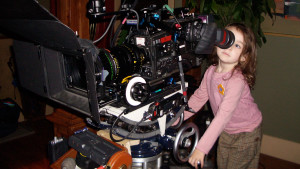 John from Israel emailed me to ask what format most Hollywood films are shot on – film or digital. The question is rather topical as recently we’ve seen a number of high profile films choose to shoot on film, including Star Wars: The Force Awakens and The Hateful Eight.
John from Israel emailed me to ask what format most Hollywood films are shot on – film or digital. The question is rather topical as recently we’ve seen a number of high profile films choose to shoot on film, including Star Wars: The Force Awakens and The Hateful Eight.
I looked at the cameras used to shoot the top 100 US-grossing films for each year over the past two decades (1996 to 2015 inclusive).
Film vs digital among Hollywood movies
The first year in which top-grossing films were shot on digital cameras was 2002, however it wasn’t until 2012 that at least half of the films were shot digitally.
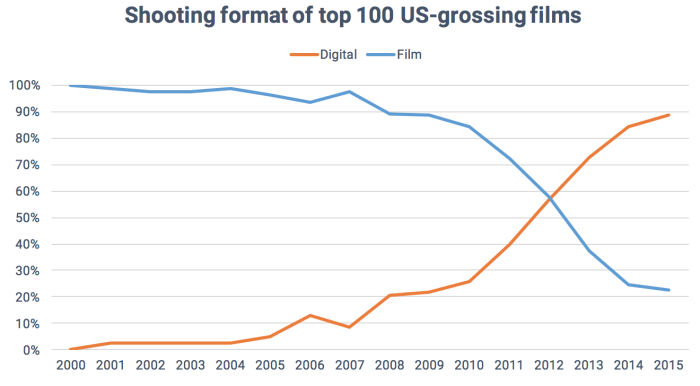
Sci-fi movies are twice as likely to be shot digitally compared to War films.
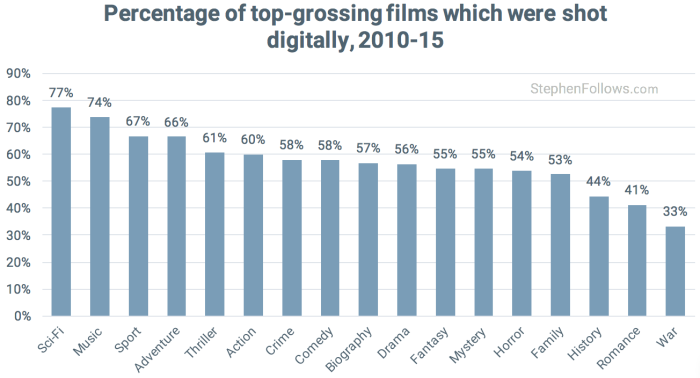
I showed these stats to a friend who is a Director of Photography and his thoughts were “History films shoot film more because it’s softer and people associate it with a period look now and Romance because film still makes actors look more attractive than digital”.
Which film sizes are used in Hollywood?
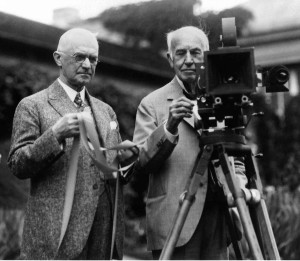 The biggest differences between film cameras is the type of film you want to shoot on – the larger the film frame, the better quality the image as there is more space to capture detail. The most common formats include…
The biggest differences between film cameras is the type of film you want to shoot on – the larger the film frame, the better quality the image as there is more space to capture detail. The most common formats include…
- 16mm – The smallest size used on professional Hollywood movies is Super 16mm, which will be used either when the filmmaker wants a gritty look or in an effort to save money. It was used on films such as Leaving Las Vegas, Evil Dead and Chasing Amy.
- 35mm – The traditional film stock used by the vast majority of movies which shoot on film.
- VistaVision – VistaVison uses normal 35mm film stock but runs it sideways to give 65% more space to each image.
- 65mm – Used mostly by directors who have the power to demand the extra budget needed (such as Paul Thomas Anderson’s The Master and Tarantino’s new flick The Hateful Eight) or when the final movie will be distributed on IMAX screens.
- 70mm – Film stock which is twice as big as big as 35mm. Films projected on 70mm are normally shot on 65mm and blown up to 70mm.
The bigger the film size, the more it will cost (to buy and process) as well as adding size and weight to the cameras you need to use.
Which digital cameras are used in Hollywood?
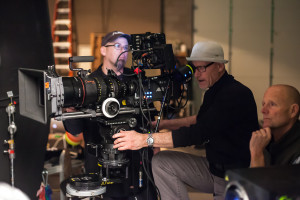 When it comes to digital cameras there are so many different variables that it can make your head spin. There’s the frame size (i.e. 2K, 4K, etc), the level of compression (i.e. trying to make best use of hard drive space without compressing the image noticeably), chroma subsampling (which is labeled as 4:4:0, 4:2:2, 4:2:0, etc and is a complex topic – it looks at the level of detail you’re capturing by three different measures.).
When it comes to digital cameras there are so many different variables that it can make your head spin. There’s the frame size (i.e. 2K, 4K, etc), the level of compression (i.e. trying to make best use of hard drive space without compressing the image noticeably), chroma subsampling (which is labeled as 4:4:0, 4:2:2, 4:2:0, etc and is a complex topic – it looks at the level of detail you’re capturing by three different measures.).
The lowest-priced cameras which were used on my dataset of 2,000 top US-grossing Hollywood films are GoPros (from around £250) and Canon EOS (from around £2,000). The GoPro is a tiny, light, durable camera which was designed to capture footage that’s impossible with normal cameras (i.e. action sports) and the Canon EOS cameras are essentially souped-up digital stills cameras. At the other end, a new RED Scarlet Dragon will set you back around £8,600 and a Sony PMW-F55 CineAlta will cost from £20,000. Most of these prices are purely for the camera body, which means you need to also buy matte boxes, lenses, viewfinders, batteries, hard drives, etc.
The most commonly-used digital camera was the Arri Alexa, followed by the RED Epic and the Sony CineAlta.
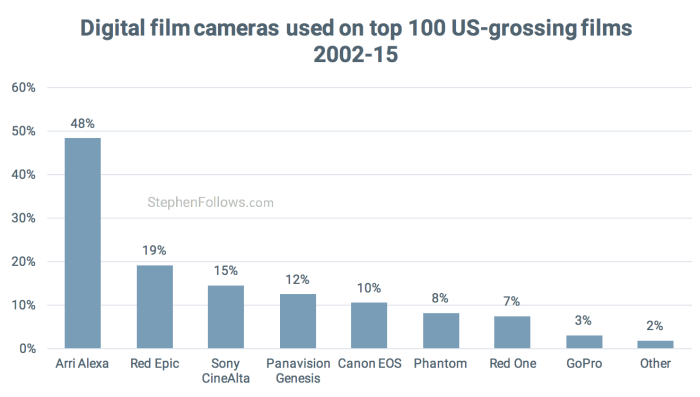
Out with the old…
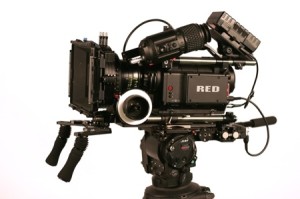 The life cycle of digital cameras is much quicker than that of older film cameras. I shot an IMAX film a few years ago and we used a VistaVison camera which was over 40 years old. By contrast, take a look at the lifespan of the RED One…
The life cycle of digital cameras is much quicker than that of older film cameras. I shot an IMAX film a few years ago and we used a VistaVison camera which was over 40 years old. By contrast, take a look at the lifespan of the RED One…
- March 2007 – The RED One was first tested professionally by Peter Jackson in March 2007 on a short film called “Crossing the Line“.
- August 2007 – The first batch of cameras were released to the public.
- February 2008 – ‘Jumper‘ released in cinemas, featuring 2nd Unit footage shot on the RED One.
- Films released in 2009 – 10% of the top 100 US-grossing released in 2009 used a RED One for some of their shots.
- Films released in 2012 – The RED One has been fully replaced by the RED Epic among top 100 US-grossing films.
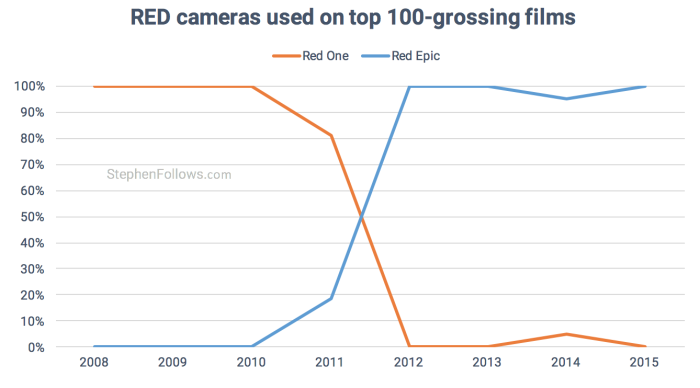
Aspect ratio of Hollywood movies
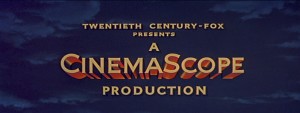 Regardless of whether productions choose to shoot on film or digitally, they will also have to pick an aspect ratio. This is the ratio of the width of the frame to the height, commonly expressed as a ratio such as 1.85 : 1. In the early days of film, movies were 1.33 : 1 (also called 4:3) which is close to being a square frame. However, when television came along and used the 4:3 format, Hollywood looked for new ways to make the cinema look bigger. They experimented with ever-wider formats, including ToddAO (2.20 :1), CinemaScope (2.35 : 1), anamorphic (2.39 : 1 ) and Cinerama (2.59 : 1) to name just a few.
Regardless of whether productions choose to shoot on film or digitally, they will also have to pick an aspect ratio. This is the ratio of the width of the frame to the height, commonly expressed as a ratio such as 1.85 : 1. In the early days of film, movies were 1.33 : 1 (also called 4:3) which is close to being a square frame. However, when television came along and used the 4:3 format, Hollywood looked for new ways to make the cinema look bigger. They experimented with ever-wider formats, including ToddAO (2.20 :1), CinemaScope (2.35 : 1), anamorphic (2.39 : 1 ) and Cinerama (2.59 : 1) to name just a few.
Most normal Hollywood movies decided on 1.85 : 1, which become the defacto standard from the mid 1950s up until around 2000. However, television started to copy the widescreen format, with 1.77 : 1 (also known as 16:9) becoming the normal for DVDs, Blu-ray and television broadcasts. From my research below, we can see that in response Hollywood has done what it did last time television stepped on its turf – it got wider.
Over two thirds of the top 100 US-grossing Hollywood films are now shot in 2.35 : 1, with under a third being released in 1.85 : 1.
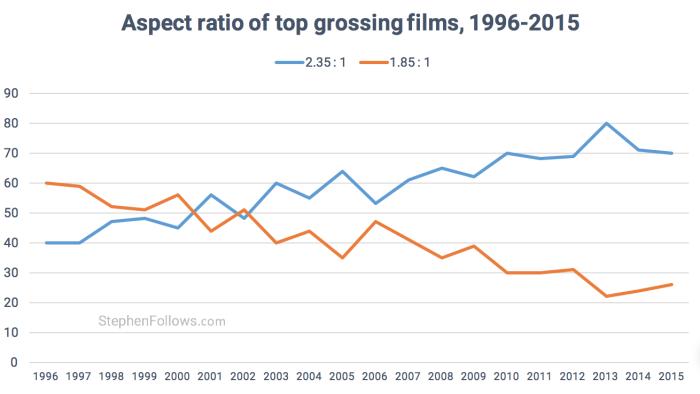
If you would like to know more about Hollywood aspect ratios then I highly recommend this fun, fact-packed video from FilmmakerIQ called ‘The Changing Shape of Cinema: The History of Aspect Ratio‘.
Methodology and notes
Here are some notes on today’s findings…
- The data came from IMDb and Wikipedia, both of which rely on user-submission, therefore we cannot be sure it’s complete and up-to-date.
- Across the twenty-year period, I found data on 84% of films, and the percentages in the charts above relate to the films for which I have data (i.e. 100% represented all of the films I have data for, not all of the top-100 films that year).
- Some films use more than one type of camera, although cannot know to what extent each camera is used. Therefore, if a film was shot primarily on 35mm but had one dream sequence shot digitally then in this research it would appear on both the ‘film’ and ‘digital’ lists.
- I’ve grouped the Canon EOS cameras together as they are a very different type of camera compared to the Arri Alexa et al and because if I didn’t then they would all get lost in the ‘Other’ category. The ‘Canon EOS’ category includes 5D Mark II, 5D Mark III, C500, 1D Mark II and the 7D.
Epilogue
Over the holiday period I have achieved two things – I watched every episode of Game of Thrones from start to finish and I got close to finishing my report on female directors in the UK film industry. The negative way it portrays women in its chaotic male-centric world was tiresome, so it was good to have Game of Thrones for light relief.
The report is for Directors UK and will be published in mid-February at the Berlin Film Festival. I’ll be sure to share my findings on this blog too.

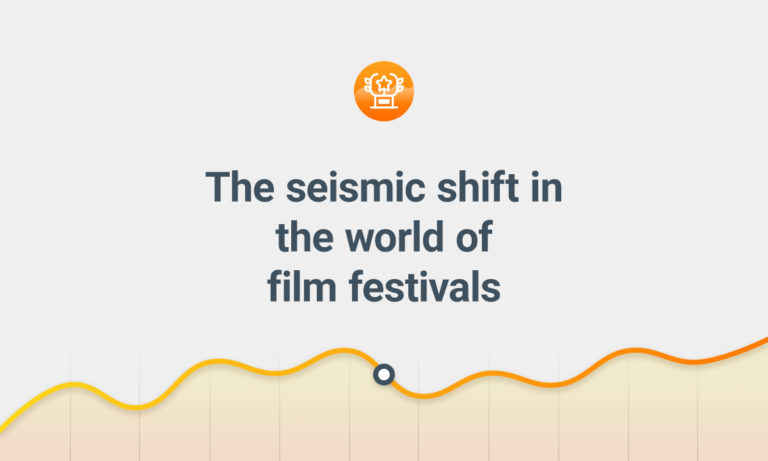
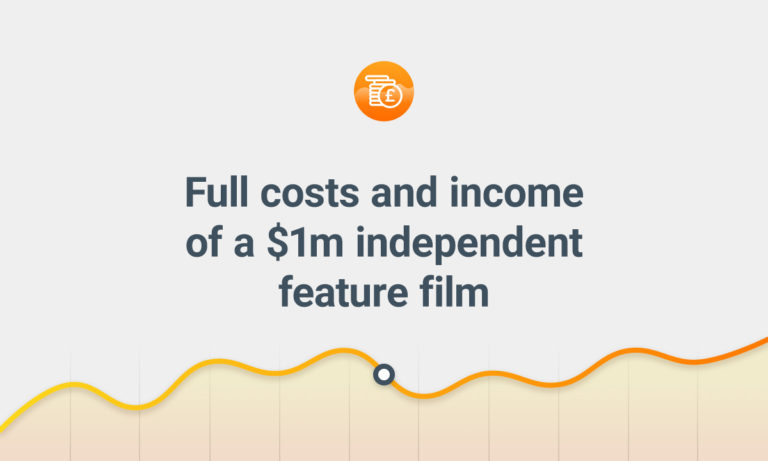
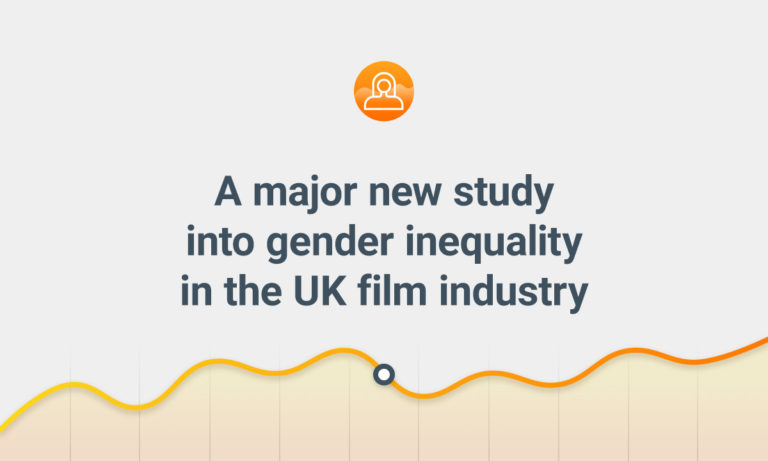

Comments
Thanks for this Stephen, it makes for a very interesting read.
Thanks for the article. Two questions. Why an anomaly in 2007 on film vs digital usage? and why do aspect ratios consistently fluctuate?
With a relatively small number of films (just 100 each year) it’s not surprising that we see a few bumps along the way. It’s nothing important.
Not sure exactly about aspect ratios. My theory would be that aspect ratios don’t have such immediate financial consequences (i.e it’s not cheaper or more expensive to films 1.85:1 or 2.35:1) compared with the shooting format so there’s less pressure to move one way or another.
Screen ratios: the broader the aspect ratio (ie, at worst 1.85: 1 compared to the old standard 1.33: 1) the higher the cost to allow for both simultaneously. The older format required that sets had to be higher (say, for the sake of argument, 10% higher. Plus microphones had to work further away from the actors in order to avoid being photographed in the 1.33 format). In the ‘old’ days, distributors (Warner Bros, MGM, Disney, Columbia, et al) insisted that both 1.85: 1 had, additionally, to ensure that nothing appeared below the 1.33:1 (ground-glass camera markings) allowed for ‘TV’ projection.
Good at penny-pinching, the money marvins wrongly assumed that there were no such penalties for doing this. It sometimes produced time-costly efforts at topping up sets, or post-synching dialogue. It surely would have been far cheaper to print up a master 1.33 : 1 monoprint especially for TV sales – and to hell with the accuracy of the side-to-side format. Who the hell cared about that, except image conscioius directors, cinematographers and camera operators!
Great post!
The new Star Wars was shot on film and the New 007 was as well.
Gotta admit, I prefer the ever so slight grainage of the film compared the relatively sparseness of grainage in digital films!
Videotape however… That doesn’t look as good at all when compared to film – I do realise that Videotape is cheap compared to film and I can see why TV networks preferred to use it for cost effectiveness
Video tape isn’t used anymore….not even in television. Movies are recorded on a hard drive or some other sort of capture media.
Film > Digital
Widescreen > Fullscreen
Just my 2 cents.
Thanks! A lot of work has gone into this.
What an interesting look at an equally interesting topic. Thanks for taking the time to dive into the numbers too.
It’s ToddAO not ToddAD.
Opps, typo. Thanks for pointing it out. I’ve fixed it.
your line-graph shows 2015 as 89% digital and 21% film – that’s 110%?
Yes – films sometimes use both
These data may not be very accurate. but it is suggestive of digital taking an upper hand over film. If there was a 2.35:1 format in 16mm films, I am sure many would re work the economics of film. It is actually cheaper for pro. ( shot @ 5:1 ratio ).
As and old standard 70mm projectionist and more recent 70mm IMAX projectionist, my observation of the 65mm negative and 70mm positive is that the 70mm images are not blown up from 65mm and sprocket locations are the same. 70mm had an extra 2.5mm outside of the sprocket area where the magnetic sound stripes were located. I know. Not a major point.
I would like to know when referring to digital movies as being “filmed” rather than “shot” or “recorded” took place. Seems a slap in the face to movies actually made on film (which I still think look better).
100% correct. Thanks Doug.
I think many people feel shame when they talk about electronic imaging as digital. They tend to avoid it.
Digital has social inferior meaning(and negative psychological impact) compared to other classical visual forms of arts. Also, digital denotes truly no craftsmanship.
So, in a non declared agreement, practitioners have chosen to use film and photography terminology, in the place of the true and correct electronic imaging terminology.
How do you know?
Star Wars Episode VII was filmed using film and the graph says digital cameras were used the most in Sci- Fi. Was this one of the few Sci Fi Films using original film?
Stephen —
Awesome information. Where does this sort of data come from? Where did you source it?
Thanks for any feedback.
Excellent info, thanks a lot!
So here’s the deal.
I run a photo studio with half a million copyrighted images. They are negatives, chromes, and transparencies.
We scan to make digital prints, so we have terrabyte hard drives as big as tables with thousands of images in TIFF. We have, of course the same images on celluloid.
The scanned digital images on the servers are bounced from hard drive to hard drive, redundantly, to protect the files if a hard drive fails. Yet the servers are warrantied for three years each. The cost per decade for this image storage, for me, seems to be $30,000.00
The celluloid negatives and chromes will last for hundreds of years on a shelf 10 feet wide… possibly they will last thousands of years. No one really knows. The cost for these 10 feet of shelf space every 10 years is free.
I don’t know what will happen over the next 100 years. But I guarantee you this: 500 years from now there will be no digital files – images or film – from 1990 to 2050.
None.
The academy did a study and showed that it was approximately 12 times more expensive to archive on digital technologies than on analog technologies. And there is no way much of this data is going to be even remotely sustainable. We are making temporary content now.
Hi Frank, That’s a really interesting point. I’m a reporter for Quartz (qz.com) and I’m writing about lost TV episodes from the 60s and 70s, when broadcast TV was often considered disposable. It’s fascinating that many of today’s digital image and film archives may one day be lost too. I’d love to learn more. Would you be up for a quick phone chat? I’m at ashley [at] qz.com if you’re interested. Cheers.
That’s simply incorrect. There will soon be silicon based digital storage that will be capable of storing large amounts of read-only information in a silicon lattice that will last an eternity.
That too was the prediction of optical media twenty-five years ago. Alas, not so.
Thank you for this article. I am a big fan of shooting film because I love the experience of developping film myself. It is an experience that digital can’t replace.
Very useful information, thanks
Hi Stephen,
A teacher who previously worked in technology and as a performer, I found your blog on
DIGITAL AND FILM extremely helpful. I look forward to being a subscriber. Thanks for educating this educator!
What I find interesting is that although 2/3 of today’s movies are predominantly shot in 2.39:1, although 1.85:1 is still a cinema standard. For me, I do prefer the taller 1.85:1 aspect ratio in general because it adds more height to the images I create. As an IMAX fan, when I discuss the framing of a big movie, I’ll tell my crew that “I want to make a film that can be seen in an IMAX theatre and in regular theaters & at home as well.” However, I’ll also use the 2.39:1 format for screens that can handle that aspect ratio as well.
My local cinema just outside of Brisbane shows all movies in 16:9 tv screen ratio. I went to watch the latest Star Wars movie and found this out. I was robbed!
where did you get your data?
My son is doing a statistics report on this topic & needs open source data sets
Thanks for the great article. My dad was a camera operator with several companies (Technicolor,Fox and Twentieth Century-Fox. ) I always thought the best cinematography was in VistaVision films (so clear and sharp). The best color was the original three strip Technicolor!
I was wondering whether you know any statistics on film vs digital editing in films (from the 90s onwards)
I hope Hollywood film companies will never stop shooting films in 35mm and 70mm formats and replace those with digital filming, as Quentin Tarantino seems to fear will happen. As with shooting on videotape, shooting in digital format is okay for some projects (such as experimental or for a special effect, as when trying to capture a “live” look, such as when filming a stage play) or to reduce costs when finances won’t permit the more spectacular film shooting methods. But most of cinema’s history at this point is defined by 35mm filming and that format should remain the standard, at least until something even more spectacular would be developed. So I basically agree with Mr. Tarantino, which would preserve the film shooting methods of great Hollywood directors such as Frank Capra, Michael Curtiz, Victor Fleming, John Ford, George Cukor, Howard Hawks, William Wyler, Alfred Hitchcock, Orson Welles, Elia Kazan, Billy Wilder, Martin Scorsese, etc.
I can tell when a movie has been shot digitally as it looks “too smooth”‘ like a TV programme. You would not think that with the frame rate that film movies are shot at that you would notice any flicker at all; the flicker is essential for the “look” of a film. The first time I noticed this was on a war movie called “Stalingrad” it looked like I was watching a TV drama not a film
I shoot professionally and always use film. For the tonal range and exposure latitude, digital is pretty crippled. Look at any digitally shot movie or still photo and you’ll see either good exposure on the highlights, or good exposure on the shadows. It can’t do both w/ out blowing out the highlights or muddying the shadows. The exposure latitude just ain’t there.
This means that a digitally shot film can’t reproduce the beautiful range of life that we see w/ our eyes, resulting in images that stick to the middle scale. Many photographers and cinematographers try and compensate for digital’s shortcomings by making images w/ very compressed tonal ranges in the hope of fooling the viewer that they’re looking at olde time tinted imagery. We’ve all seen these attempts of making digital “look” film like. Sorry, the information just isn’t there in a digital file.
For B&W it’s even worse, as digital B&W gets you a lot of grey and white, while film will give you true black and white w/ all the shades in between. Besides, digital images just look plain odd. They’re devoid of detail, and compensate w/ extra sharpness and contrast solely at the edges (acutance), which tricks the eye into thinking that digital is “sharper”. I basically can’t stand to watch a movie that’s been filmed 100% digitally. It just looks plain ugly to me, and not at all lifelike. Same w/ gallery photos. But here’s the thing….w/ film you reeeeely have to know what you’re doing every step of the process, and it’s an expensive proposition to shoot film. Most people don’t have the money or the technical skills anymore, so they shoot digital
I will not buy 4K blu-ray movies shot with a 2K digital camera. and there is a lot of them. but I will buy one of an old movie shot with 35mm. star wars from 1977 looks fantastic in 4K
In a social situation last year, I met a man who is a technician in Hollywood and we chatted briefly about film vs digital. He said some film is still used but it was more than three years earlier that he last worked on a movie that was shot on film. Obviously, that one man’s experience doesn’t say it all but it’s indicative of where things have gone.
Yet, vinyl audio seems as if it will never entirely fall to its digital rivals. Strange.
thank you very nice post
Thank you men very good post.
Awesome! Its genuinely remarkable post, I have got much clear idea regarding from this post
Stephen, I learned so much from your article. Thank you.